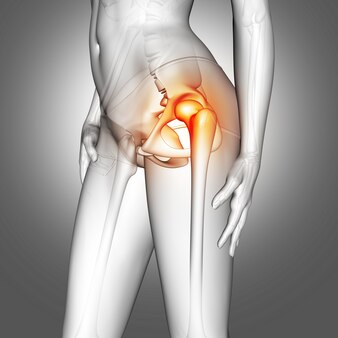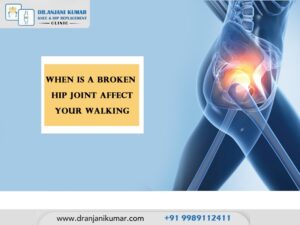The selection of the best hip replacement for younger patients depends on factors like age, activity level, health, and hip joint damage. Consultation with an orthopaedic surgeon is crucial to determine the best option. Advancements in hip replacement have helped young people stay active longer, relieve pain, improve mobility, and enhance quality of life. Although more commonly associated with older adults, technology has made hip replacements more viable and successful for younger patients. Technology has contributed to improved outcomes and expanded the potential for hip replacement surgery in younger patients.

Advanced technological hip replacement is best for younger patients:
- Advanced materials:
- Modern hip replacement implants use advanced materials like ceramics and highly cross-linked polyethene, which are more durable and have lower wear rates.
- This increased durability allows younger patients to maintain their active lifestyles without worrying about premature implant wear.
- Custom implants:
- 3D printing and computer-aided design (CAD) have enabled the creation of custom-designed hip implants that are tailored to the patient’s unique anatomy.
- Custom implants can provide a better fit and potentially better outcomes, especially for younger patients with atypical hip anatomy.
- Minimally invasive surgery:
- Robotic-assisted and computer-guided surgery have improved the precision and accuracy of hip replacement procedures.
- Minimally invasive techniques result in smaller incisions, less tissue damage, and quicker recovery times, which are especially beneficial for younger patients looking to return to their active lives as soon as possible.
- Navigation systems:
- Surgeons can use navigation systems that provide real-time feedback during surgery, helping them achieve precise implant positioning.
- It reduces the risk of complications and can extend the lifespan of the implant.
- Improved imaging:
- Advanced imaging techniques, such as CT scans and MRI, allow for better pre-operative planning and assessment of hip joint conditions.
- Surgeons can make more informed decisions about the most appropriate surgical approach.

- Pain management:
- Enhanced pain management techniques, including regional nerve blocks and less invasive anaesthesia, have reduced post-operative pain, enabling quicker mobilization and rehabilitation.
- Rehabilitation and monitoring:
- Wearable devices and mobile apps are now used for tracking patient progress and monitoring rehabilitation exercises.
- These tools help patients and healthcare providers collaborate more effectively in the recovery process.
- Telemedicine:
- Telemedicine has become more prevalent, making it easier for patients to consult with their healthcare providers before and after surgery.
- It facilitates ongoing care and support, even for those who live in remote areas.
- Long-term follow-up:
- Advances in healthcare IT systems and electronic medical records enable long-term tracking of hip implant performance and patient outcomes.
- This data helps identify issues early and supports continuous improvement in hip replacement technology.
- Patient education:
- Technology allows for better patient education and engagement, helping younger patients understand the benefits, risks, and expectations of hip replacement surgery.
- Informed patients are more likely to have realistic expectations and actively participate in their recovery.
Technological advancements have significantly improved hip replacements for younger patients, allowing them to enjoy an active lifestyle with reduced pain and improved hip function. Despite inherent risks, the combination of improved materials, surgical techniques, and patient support has led to more successful and long-lasting hip replacements. However, each patient’s case is unique, and the decision should be made with a qualified orthopaedic surgeon.
Primary reasons and causes for young patients to consider hip replacement:
Hip replacement surgery is often performed on young patients for various reasons, although it is more commonly associated with older adults.
- Hip osteoarthritis:
- Osteoarthritis is a common cause of hip pain and deterioration of the hip joint.
- While it is more prevalent in older adults, younger individuals can also develop osteoarthritis due to factors such as joint abnormalities, genetics, joint injuries, or excessive wear and tear.
- When conservative treatments fail to provide relief, hip replacement surgery may be considered.
- Rheumatoid arthritis:
- Younger patients may be diagnosed with rheumatoid arthritis, an autoimmune condition that can affect the hip joint and lead to joint damage.
- When medications and other treatments are ineffective at controlling the disease and its associated pain, hip replacement may be necessary to restore function.
- Hip dysplasia:
- A congenital disease known as hip dysplasia causes the hip joint to develop incorrectly.
- It can lead to pain, instability, and early joint degeneration.
- In some cases, especially when diagnosed early, hip replacement surgery can improve function and quality of life for younger patients with hip dysplasia.
- Avascular necrosis(Osteonecrosis):
- The destruction of bone tissue results from avascular necrosis, which happens when the hip joint’s blood supply is cut off.
- In addition to trauma, steroid use, alcohol abuse, and certain medical conditions can cause this.
- Hip replacement may be necessary when the hip joint becomes severely damaged.
- Post-traumatic arthritis:
- Young individuals who have experienced significant hip injuries or fractures may develop post-traumatic arthritis over time.
- This type of arthritis can lead to joint pain and deterioration, requiring hip replacement surgery to alleviate symptoms and restore function.
- Inflammatory arthritis:
- Inflammatory arthritis conditions such as ankylosing spondylitis and psoriatic arthritis can affect the hip joint in younger patients, leading to joint damage and pain.
- When conservative treatments are ineffective, hip replacement may be considered.
- Overuse or sports-related injuries:
- Young athletes or individuals who engage in high-impact sports may develop hip injuries, labral tears, or cartilage damage over time.
- In cases of severe and chronic damage, hip replacement surgery may be recommended to address pain and functional limitations.
- Genetic factors:
- Some individuals may have genetic factors that predispose them to hip joint problems, such as developmental abnormalities or conditions like Legg-Calvé-Perthes disease.
- These conditions can contribute to hip pain and joint degeneration, necessitating hip replacement in some cases.
Hip replacement surgery is often the last resort for young patients after conservative treatments like physical therapy, medications, and lifestyle changes have not provided relief. The decision should be made in consultation with an orthopaedic surgeon.
An unhealthy lifestyle plays a vital role in hip problems for young individuals:
Unhealthy lifestyles can increase the need for hip replacement surgery in young patients, but these factors are often part of a broader, complex issue.
- Obesity:
- Excess body weight can place significant stress on the hip joints.
- Obesity is associated with a higher risk of developing hip osteoarthritis, which can ultimately lead to the need for hip replacement surgery.
- Sedentary behaviour:
- A sedentary lifestyle, characterized by prolonged periods of sitting or inactivity, can weaken the muscles surrounding the hip joint and reduce joint flexibility.
- This lack of physical activity can contribute to hip pain and dysfunction.
- Poor diet:
- A diet high in inflammatory foods, such as processed foods, sugary beverages, and excessive amounts of red meat, may promote inflammation in the body.
- Chronic inflammation can potentially accelerate joint degeneration and increase the risk of hip problems.
- Smoking:
- Smoking has been associated with reduced blood flow to bones and tissues, including those in the hip joint.
- Reduced blood flow can impair the body’s ability to repair and maintain joint health, potentially leading to hip issues.
- Excessive alcohol consumption:
- Heavy alcohol consumption can weaken bones and increase the risk of falls and injuries, which may contribute to hip problems.
- High-impact sports or activities:
- Engaging in high-impact sports or activities without proper conditioning, warm-up, and technique can lead to hip injuries, labral tears, and cartilage damage.
- Over time, these injuries may necessitate hip replacement surgery.
Hip problems in younger patients are often multifactorial, influenced by genetic predispositions, underlying medical conditions, and prior injuries. However, not all young patients with unhealthy lifestyles will develop hip problems, and not all hip problems are related to lifestyle choices. Maintaining hip health involves regular exercise, a balanced diet, weight management, smoking cessation, and moderation in alcohol consumption. If hip problems persist, conservative treatments like physical therapy and medications are often the first line of intervention. Hip replacement surgery is considered when these measures fail, and the decision should be made in consultation with a healthcare provider based on the patient’s unique circumstances and the severity of their hip condition.
About Dr Anjani Kumar
As an orthopaedic surgeon in Hyderabad, I try to provide patients with as many options as possible for hip and knee treatments to help each patient have the greatest results. I carefully consider the specific sorts of injuries and need to be comfortable offering a specialised solution before recommending the best course of therapy for each patient. My patients’ enhanced mobility and pain reduction are always my top priorities, as these will enable them to resume an active lifestyle. In more severe cases, especially when the joint has collapsed, or the bone has suffered extensive deformation, knee replacement surgery may be advised.
Knee replacement surgery may be recommended in advanced cases, especially if the joint has collapsed or the bone has become severely deformed.
Dr Anjani Kumar has 20 years of experience and successfully performed 2000 knee replacement surgeries, 350 hip replacement surgeries, and 500 pelvic acetabular surgeries throughout his career. Please get in touch with us on Mobile: at +91 9989112411 and by E-mail: anjanikumar@ gmail.com




